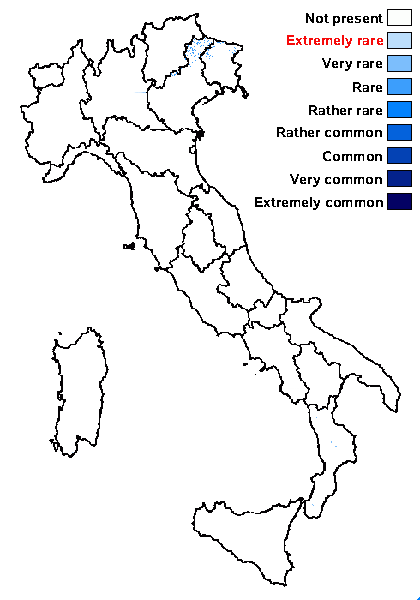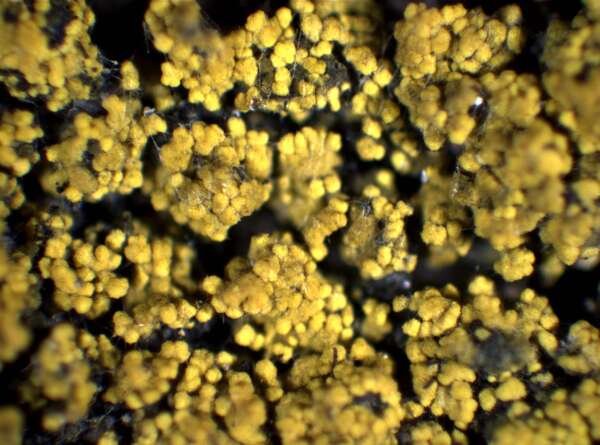Candelariella kuusamoënsis Räsänen
Ann. Soc. zool-bot. Fenn., 12, 1: 58, 1939.
Synonyms:
Distribution: N - Frl (Tretiach & Hafellner 2000), Ven (Nascimbene & al. 2021), Lig (TSB 33559). S - Cal (Lich. Graec. 285: Obermayer 2006, Puntillo 2011).
Description: Thallus crustose, episubstratic, dark orange-yellow, thick, composed by closely packed, up to 0.3 mm wide granules gathered into a continuous to cracked-areolate, almost pulvinate crust of small, effigurate to almost granular areoles. Apothecia rare, lecanorine, sessile, 0.3-1.5 mm across, with a yellow to grey-yellow, flat to somewhat convex disc and a thin to thick, entire to crenulate, persistent margin. Proper exciple often visible from the outside; epithecium yellow-brown; hymenium colourless, 55-75 µm high; paraphyses simple or sparingly branched in upper part, cylindrical or with weakly swollen tips, the apical cells up to 3.5 µm wide; hypothecium colourless. Asci 12-16(-32)-spored, clavate, with an apical dome which is I+ blue only in the internal, lower part, interrupted in the centre by an I+ paler blue strip, Candelaria-type. Ascospores 1-celled to 1-septate, hyaline, oblong-obtuse, 9-14 x (3-)4.5-5.5(-6.5) µm. Photobiont chlorococcoid. Spot tests: thallus and apothecia K- or K+ reddish-orange, C-, KC-, P-, UV-. Chemistry: calycin, pulvinic acid, pulvinic dilactone and vulpinic acid.Note: a boreal-montane, poorly understood lichen found on the top of poles and wooden fences, on plant debris and soil, more rarely on rocks in upland areas; certainly more widespread in the Alps. The delimitation of this species is problematic: most of the material distributed in exsiccata belongs to other species, and it is doubtful whether the material called “C. kuusamoensis” by Central and Southern European authors really corresponds to the type material, which in itself resembles a luxuriant C. vitellina growing on mosses (Westberg, in litt.).
Growth form: Crustose
Substrata: lignum, soil, terricolous mosses, and plant debris
Photobiont: green algae other than Trentepohlia
Reproductive strategy: mainly sexual
Poorly known taxon in need of further study
Commonnes-rarity: (info)
Alpine belt: absent
Subalpine belt: rare
Oromediterranean belt: very rare
Montane belt: absent
Submediterranean belt: absent
Padanian area: absent
Humid submediterranean belt: absent
Humid mediterranean belt: absent
Dry mediterranean belt: absent

Predictive model
Herbarium samples
Growth form: Crustose
Substrata: lignum, soil, terricolous mosses, and plant debris
Photobiont: green algae other than Trentepohlia
Reproductive strategy: mainly sexual
Poorly known taxon in need of further study
Commonnes-rarity: (info)
Alpine belt: absent
Subalpine belt: rare
Oromediterranean belt: very rare
Montane belt: absent
Submediterranean belt: absent
Padanian area: absent
Humid submediterranean belt: absent
Humid mediterranean belt: absent
Dry mediterranean belt: absent

Predictive model
| Herbarium samples |
 INDEX FUNGORUM
INDEX FUNGORUM
 GBIF
GBIF
 DOLICHENS
DOLICHENS




